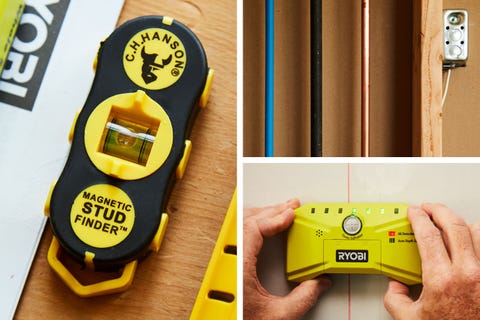stud finder
The Best Stud Finders
A stud finder is good for, well, finding studs you can’t see. Knowing where those are is crucial so you can be sure to screw into them instead of just the drywall when you’re hanging something heavy, like a mirror or a mount for, say, a flat-screen TV. But some stud finders have other features, too, like deep scanning and AC wire detection.
That doesn’t mean they always do what they’re supposed to. There’s a lot going on in walls, and it can be hard, despite advances in tech, for any device to parse it all and determine what’s a pipe and what’s a wire from outside of the wall. To test all the features, we put a selection of stud finders through their paces on a wall of our own making, as
well as walls in existing homes. For our test, we built a four-by-eight-foot wall out of common materials: wood and metal studs; drywall; copper, black, pex, and PVC pipe; and nonmetallic sheathed cable. Then we scanned the wall with each of the stud finders. All functioned as expected when it came to detecting the studs, but we quickly found
For our test, we built a four-by-eight-foot wall out of common materials: wood and metal studs; drywall; copper, black, pex, and PVC pipe; and nonmetallic sheathed cable. Then we scanned the wall with each of the stud finders. All functioned as expected when it came to detecting the studs, but we quickly found
 For our test, we built a four-by-eight-foot wall out of common materials: wood and metal studs; drywall; copper, black, pex, and PVC pipe; and nonmetallic sheathed cable. Then we scanned the wall with each of the stud finders. All functioned as expected when it came to detecting the studs, but we quickly found
For our test, we built a four-by-eight-foot wall out of common materials: wood and metal studs; drywall; copper, black, pex, and PVC pipe; and nonmetallic sheathed cable. Then we scanned the wall with each of the stud finders. All functioned as expected when it came to detecting the studs, but we quickly found that a number of them designed to pick up the location of live AC wiring simply didn’t. We checked with product engineers and found that steel studs, metal pipe, and ductwork could impair live-wire detection. So we went back to our test wall, removed the steel studs and metal pipes, and built a second four-by-four-foot wall to test only the steel studs. Again,
stud detection went as expected, but the devices did only a slightly better job of finding the live wires. A couple did, however, manage better than the others. We also took the stud finders to two homes—one a mid-1800s house with lath and plaster, and the other a 1970s tract house—for real-world testing.
Comments
Post a Comment